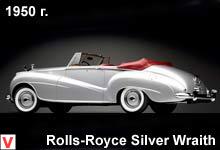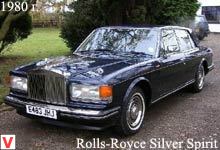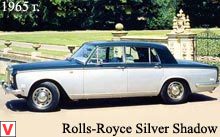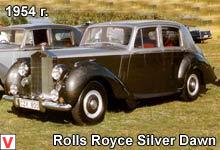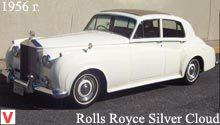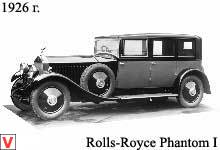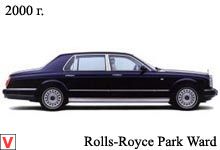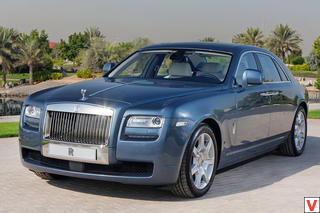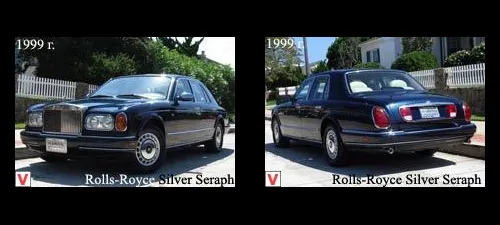
Rolls-Royce Silver Seraph was presented at the International Automobile Exhibition in Geneva in March 1998. The car was the ninth model for the 95-year history of the company and the first model that does not fully comply with the superconservative canons of Rolls Royce. Since the first Rolls-Royce 40/50 car with a silver body (he earned the nickname Silver Ghost) was presented at the Olympia motor show in 1906, all of the Cru vehicles wore the Silver prefix. The Silver Seraph sedan was no exception. For the English, Seraph is the angel of the highest rank carrying the light. The car was replaced in the production program model Silver Dawn and Silver Spur.
Work on the car (it was code-named P3000) began in March 1994. For the production of this model, the owner of Rolls-Royce, the military-industrial concern Vickers, has invested 40 million pounds sterling in the modernization of the company's plants in Crewe. For the first time in the company's history, cars were assembled on an overhead conveyor, but still manually.
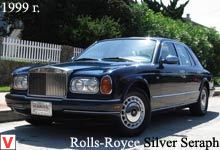
Designers Rolls-Royce managed to give the new car a trendy roundness of the lines, while not violating the conservative traditions of the British automotive industry. The exterior is distinguished by twin round headlights under a common cap, vertical blocks of “turn signals” and a not-so-monumental grille like its predecessors. The extended waistline, smoothly turning into the front fenders, the “recessed” cabin, the tailgate protruding upward is the undoubted legacy of the Silver Cloud model. By the way, such a decision of the boot lid is not only aesthetics, but also improved aerodynamics and luggage compartment volume increased to 374 liters.
Silver Seraph has received a new, full-metal, elegantly shaped body. The torsional rigidity of the body has increased by 65% compared with its predecessors. The body is covered with ten layers of anti-corrosion composition and fourteen layers of paint. The company offered its customers to choose one of 27 standard painting options for a car or to order an individual painting option for a special order. Interior decoration will satisfy even the most demanding passenger. No other car manufacturer can boast a woodworking workshop where 90 of the best craftsmen work.
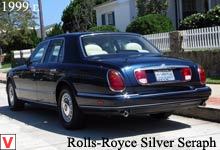
Pieces of maple, walnut or elm veneer are carefully sorted and selected to achieve the mirror effect of the fiber pattern on opposite sides of the vehicle interior. On the upholstery of the seats and other parts of the interior of the machine takes about 8 skins. The seats are electrically controlled, memorize several positions and have a two-stage heating system. Highly efficient air conditioning system allows you to set the desired temperature not only in the front and rear parts of the cabin, but also on the right and left sides. For music lovers, a first-class audio system with a 6-CD player was designed. A 5.4 liter V12 aluminum engine producing 326 hp was installed on the car.
familiar to us from the BMW 750i. The power unit is paired with a 5-speed automatic transmission company ZF. With a curb weight of 2300 kg (6% lighter than the Silver Spirit), the car accelerates to 100 km / h in 6.9 seconds, and the maximum speed is 225 km / h.
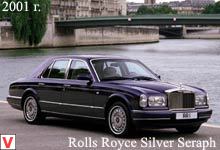
It stops in 3 seconds (stopping distance from 100 km / h is 42 m). Fuel consumption on the highway - an average of 12.8 l / 100 km, and in the city - two times higher: 25.4 l / 100 km. For Silver Seraph, a new, fully independent, lever-spring suspension on cross-forked levers with stiffer springs and an electronic system for adjusting the stiffness of shock absorbers was developed. The hydraulic self-damping electronics system of the suspension adapts to the driving speed and vibration load of the chassis, as well as provides the body alignment during cornering, braking and acceleration.
Active safety elements include a brake system with a hydraulic pump, disc brakes made according to a special technology, equipped with 4-channel ABS, traction control (ASC) and an electronic fuel pedal, an automatic light beam system for headlights depending on the body position and automatic locking of the doors when the gear is engaged and started to move (optional). Despite the high cost (from $ 250,000), this Rolls-Royce was well received in the super-expensive car market.
The largest one-time order, for 31 copies of Silver Seraph, came from Dubai - thus finally breaking the record, which had lasted since the 60s, when the Scottish Cooperative Wholesale Society ordered thirty Rolls-Royce to convert them to hearses.
